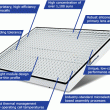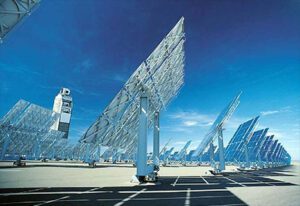Solar thermal magazine ABB Investigates Braking Energy Recovery or Solar Power?

Braking Energy Recovery or Solar Power? ABB ( Solar Thermal Magazine ) Transit agencies are placing increasing importance on pursuing sustainability in their operations. Yet they can achieve their goals with several possible scenarios from the conversion to more efficient LED lighting, the deployment renewable energy sources and others. This case study contrasts two options that are being considered by operators of DC electric rail systems today: a solar photovoltaic (PV) power system and a wayside braking energy recovery system.
Thanks to attractive government subsidies and feed in tariff programs, solar power has become an increasingly popular and a visible source of clean renewable energy.
Recovery of train braking energy, on the other hand, is an emerging trend which does not benefit from the same level of government support. This study will show that an energy storage or recuperation system installed inside a substation provides a superior ROI for transit agencies than a solar PV system.

For transit agencies, solar systems can typically be installed on roof top of large maintenance facilities or office buildings or as canopies in parking lots. Because a small system cost more per watt and has little overall impact, a rail operator would typically consider projects capable of generating several hundred kilowatts of power.
Since a rooftop PV system becomes cost efficient at capacities around 500kW, we chose to compare such a system with an energy recovery system providing equivalent energy savings.
While the cost of the solar system will vary with the complexity of the engineering, of the connection costs, of legal and financial set-up fees, and of racking and installation costs, a 500kW solar PV system typically costs between $3.50-5.00 per watt before subsidies and other incentives.
Based on PVWatts, such a system will produce, as shown in figure 1, between 496 MWh and 758 MWh per year depending on the location of the site and angle of the panels. While deploying the panels at the optimum angle produces more energy, this comes at the expense and impact of more spacing to reduce the impact of row to row shading, and at the additional expense for longer cabling runs, more racking materials and more installation work.
.jpg)
The Wayside Energy Storage or Recuperation System (ESS and ERS) Option
Electrically powered trains utilize regenerative braking, but the regenerated energy can only be used if there is another train accelerating in its immediate area. This is not always the case and much energy gets dissipated in on-board resistors.
This is why ABB introduced ENVILINETMESS (Energy Storage System) and ERS (Energy Recuperation System), two wayside systems which connect to the catenary or 3rd rail of an electric train system.
These ENVILINE systems capture the otherwise wasted braking energy, store and feed it back as needed during the acceleration (ESS), or otherwise return it to the AC grid (ERS). Depending on the time of day and frequency of trains, this saves between 5% to 20% or more of the traction energy consumed by the trains.
As showed in figure 1, and corroborated by results achieved in real operations with a 1.5 MW system costing between $450-900K depending on the configuration and installation, such ENVILINE ESS or ERS will recuperate energy generally equivalent to the production of a 500 kW PV system, yet cost less than half of the all-in costs of a solar system. Without government incentives, this option is clearly the more attractive and sustainable for a transit agency.
Other advantages of energy recuperation
An energy recuperation system offers transit authorities several additional advantages, namely:
– More stable production: Solar production follows a bell shaped curve, and can be hampered by clouds, snow and dirt. While train braking energy recuperation comes in hundreds or even thousands of small sporadic injections, the total kilowatt-hour production per hour is much more constant throughout the train operation day than solar. Because of this, a constant generation profile can be achieved with the addition of a much smaller energy storage system than with solar;
– Traction power benefits: With the ESS option, the recovered energy gets returned to the traction line during the acceleration, which cuts the peak demands on the grid by up to 2000A on a 1.5MW system. This helps maintain the voltage level and the efficiency of the traction power system, and reduces the strain on the distribution equipment;
– Less maintenance: While both systems require annual maintenance and inspection of the power electronics, a solar system requires the additional cleaning of the panels, inspection of PV wiring and connections, and may complicate structural repair or replacement if roof mounted.
– Smaller footprint: A 1.5MW energy recuperation system takes typically less than 100 ft2 of floor space inside a substation. A 500kW solar system can require between one to two acres of roof area, plus space for connection boxes, inverters, transformers and AC protection.
– Less legal & set-up constraints: An energy recuperation system connects behind the customer meter, and should not require any permitting from the local utility company. In most cases, a solar system requires a connection agreement and a PPA (Power Purchase Agreement) with the local utility or purchaser of the electricity.
Summary:
Investing in solar is a smart investment which will provide clean renewable energy for decades.
However, transit authorities operating DC electric trains can take advantage of a unique and better opportunity to deploy wayside train braking energy recovery systems which increase their energy efficiency and provide with better financial performance.
 Tags: Braking Energy Recovery
Tags: Braking Energy Recovery
Solar Thermal Magazine’s Clean Energy Page

Promote Your Page Too 




